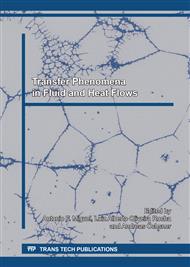p.1
p.19
p.29
p.41
p.52
p.68
p.78
p.90
Effects of Longitudinal Alignments on the Time-Mean Flow Structures of Side-by-Side Circular Cylinders of Diameter Ratio Two
Abstract:
The time-averaged flow characteristics in the regions upstream and downstream of the side-by-side cylinders of diameter ratio two, arranged at different longitudinal alignments and two gap ratios, are studied via particle image velocimetry (PIV). It is found that the locations of forward stagnation point of the large and the small cylinders do change with the longitudinal alignments. Upstream of the large cylinder, the streamwise variations of U* are nearly independent of the longitudinal alignment for both T*=1.5 and 1.0. However, upstream of the small cylinder, the streamwise variations of U* indeed depend on T*. Upstream of the small cylinder, the streamwise variations of V* are strongly affected by T* and, the largest magnitude of V* occurs at CLA for both T*=1.5 and T*=1.0. Also, the locations of the largest magnitude of V* move closer to the small cylinder as the T* reduces. For different T* and L*, the flow rate (or the averaged velocity through the gap) and the gap orientation will be changed at the same Reynolds number (Re=1000). The effect of pressure difference across the gap may be overwhelmed or be counterbalanced by that of the gap orientation leading to quite different flow structures in the downstream region of the cylinder couples. The effects of longitudinal alignment are to (1) change the forward stagnation points of the large and the small cylinders; (2) modify the region of mutual interaction between two wakes. (3) As S* reduces, the gap orientation takes the dominance over the pressure difference across the gap to switch the gap flow so that the wide-wake is formed behind the small cylinder especially for T*=1.0 and TEA.
Info:
Periodical:
Pages:
29-40
Citation:
Online since:
January 2017
Authors:
Price:
Сopyright:
© 2016 Trans Tech Publications Ltd. All Rights Reserved
Share:
Citation:


